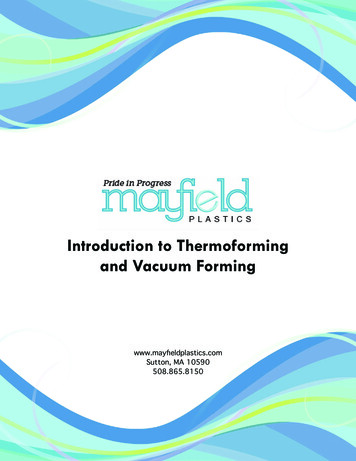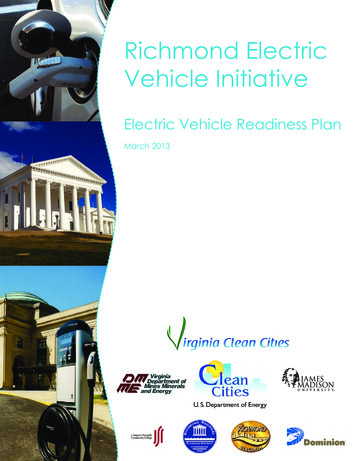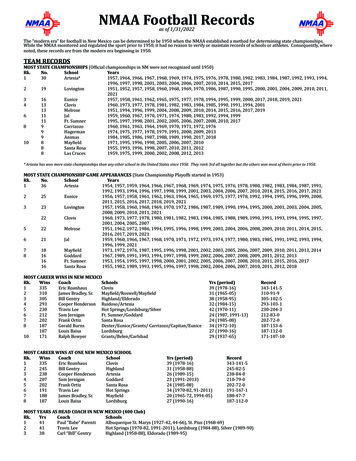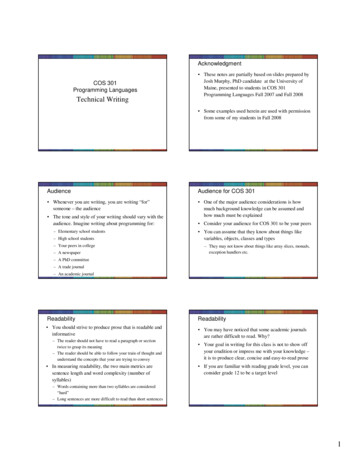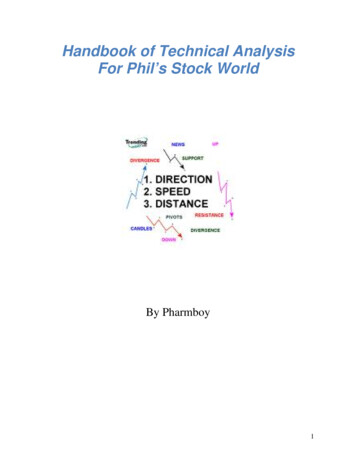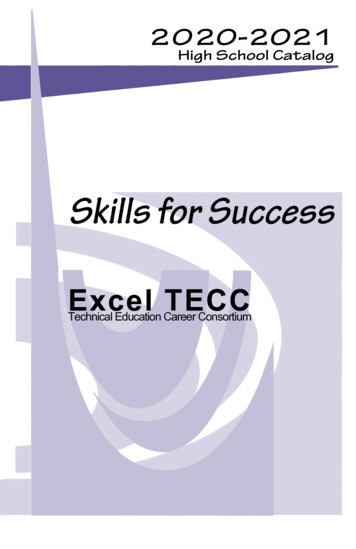
Transcription
The Mayfield Handbook of Technical & Scientific WritingMayfield Publishing has generously allowed the Siemens Foundation to post certain informationon its website. This information, which relates to citing sources and listing references in researchreports, can assist students submitting research reports to the Siemens WestinghouseCompetition. Entrants to the Competition are not required to use this information; otherinformation sources are available. The information, which comes from Chapters 10 and 15 of TheMayfield Handbook of Technical & Scientific Writing by Leslie C. Perelman, James Paradis andEdward Barrett, is the property of Mayfield Publishing. It has been provided as an aid to studentswho have entered (or may enter) the Competition. This information may not be downloaded bypersons who have not or may not enter the Competition.The Mayfield Handbook of Technical & Scientific WritingChapters 10 and 1510. Citing Sources and Listing ReferencesUsing the Language of Your Source AppropriatelyAcknowledging SourcesBasic Structure and Formats of Citation StylesCiting Online SourcesSpecific Citation StylesAmerican Psychological Association (APA) Author-Date StyleModern Language Association (MLA) Author-Page StyleChicago Manual of Style (CMS) Note CitationsCouncil of Biology Editors (CBE) Citation-Sequence SystemIEEE Citation-Sequence System15. Writer's Resources15.1 Style GuidesGeneralTechnicalElectronic SourcesDictionariesGrammar and UsageGeneral Guides to Effective StyleGuides to Scientific WritingGuides for Effective Graphs and Text FormatsInformation on Specific Topics
The Mayfield Handbook of Technical & Scientific WritingMayfield Publishing has generously allowed the Siemens Foundation to post certain informationon its website. This information, which relates to citing sources and listing references in researchreports, can assist students submitting research reports to the 2000 Siemens WestinghouseScience & Technology Competition. Entrants to the Competition are not required to use thisinformation; other information sources are available. The information, which comes from Chapters10 and 15 of The Mayfield Handbook of Technical & Scientific Writing by Leslie C. Perelman,James Paradis and Edward Barrett, is the property of Mayfield Publishing. It has been providedas an aid to students who have entered (or may enter) the Competition. This information may notbe downloaded by persons who have not or may not enter the Competition.The Mayfield Handbook of Technical & Scientific WritingChapter 10American Psychological Association (APA) Author-Date StyleModern Language Assocation (MLA) Author-Page StyleChicago Manual of Style (CMS) Note CitationsCouncil of Biology Editors (CBE) Citation-Sequence SystemIEEE Citation-Sequence SystemUsing the Language of Your Source AppropriatelyIf you use the language of your source, quote the wording exactly. This is called a directquotation. A direct quotation is either enclosed in quotation marks or indented on the page. If youomit part of the wording, use an ellipsis (three periods, four if necessary for punctuation toindicate the omission). In any case, several words in succession taken from another sourceconstitute direct quotation and must be acknowledged. Indeed, a single word may constitute adirect quotation if it is a word closely identified with a particular author.A paraphrase employs source material by restating an idea in an entirely new form that is originalin both sentence structure and word choice. Taking the basic structure from a source andsubstituting a few words is an unacceptable paraphrase and may be construed as plagiarism.Creating a new sentence by merging the wording of two or more sources is also plagiarism.The following examples illustrate the differences between acceptable paraphrase and plagiarism.Source QuotationA grand unified theory has long been the holy grail of physicists. Since ancient times, physicists havesought minimalist explanations of nature. Theories with four basic particles are considered better thantheories of ten.--Alan Lightman, Ancient Light: Our Changing View of the UniverseUnacceptable ParaphraseA grand unified theory has long been the central goal of scientists. Since the dawn of time, men of sciencehave looked for minimalist explanations of natural phenomena. A theory with four elementary particles isconsidered better than a theory of ten.In the preceding passage, the writer has merely substituted a few words of his or her own forwords in the source. The structure and the overall wording of the sentences, however, are
Lightman's. Since the writer has borrowed Lightman's words as well as his ideas, theacknowledgment of Lightman as a source does not prevent this passage from being plagiarism.Unacceptable ParaphrasePhysicists have long had the grand unified theory as their holy grail. Science always tries to giveminimalist explanations for natural phenomena. The best theory is the one with the fewest elements.The structure of the individual sentences in the preceding passage is somewhat original, but theorder of sentences is clearly taken from Lightman. In addition, the writer has used severalphrases taken directly from the source, such as "minimalist explanations of nature." Borrowingsuch phrases without enclosing them in quotation marks makes the writer guilty of plagiarism.Acceptable ParaphrasePhysicists have long sought a grand unified theory, since scientists have always preferred theories with thefewest elements (Lightman 106).This writer has reproduced much of the meaning of Lightman's passage but in a sentence that isoriginal in structure and word choice. The only major words and phrases taken from Lightman aregrand unified theory, theories, and physicists. Such duplication is acceptable, since it would becumbersome to find synonyms for these basic terms.Acknowledging SourcesCite the sources of all ideas and information that are not your own and that are not commonknowledge. All ideas and information taken from a source must be acknowledged unless they areconsidered common knowledge. The crucial term in this rule is, of course, common knowledge.There is a simple test to determine whether something should be considered common knowledgeand need not be documented: Would this idea or piece of information be familiar to someone likeyou (a classmate, for example) who has not researched the subject? If the answer is yes, thenyou do not have to cite the source. Otherwise, you must indicate the source of the material, evenif it appears in several texts. Contrary to some commonly held opinions, that an item ofinformation appears in several sources does not make it common knowledge. Some of the mostobscure facts in physics or biochemistry, for example, will appear in numerous articles or textsover the years. Still, they are hardly common knowledge.Basic Structure and Formats of Citation StylesAll academic and professional disciplines have specific systems for citing sources. What all thesesystems have in common is that they provide sufficient information to allow a reader to locate thesource of a quotation or reference. Most common citation styles share a common two-partstructure: (1) a marker in the text that acknowledges another's words, facts, and ideas and thatpoints to (2) the full source of information.
Citation styles develop this two-part structure through one of three general formats.1. Brief parenthetical information in the text linked to a list of references. The informationincluded in the parentheses provides an unambiguous link to a work in the complete list ofsources, usually listed as part of the end matter of the document. In most but not all formats, theprimary link in the parenthetical reference is the last name of the first-listed author of the source,and, consequently, most lists of references are arranged alphabetically by author. Depending onthe style and the context, parenthetical citations often include such elements as the year ofpublication, reference to exact page numbers, and a shortened title of the work. The mainadvantage of this system is that it is extremely flexible: an addition or a deletion of a referencehas little effect on other references or the reference list. The principal disadvantages are that along parenthetical reference may interrupt the text and the rules for parenthetical citations cansometimes be quite complex.2. In-text numbers linked to a list of references. Numbers are inserted in the text, usually assuperscripts or in parentheses or brackets, that refer to a list of references, in which each of thefull sources is numbered and listed once in the order in which it was first cited in the text.Subsequent references to a source in the text use the original reference number. The mainadvantages of this system are that references are less conspicuous in the text than parentheticalcitations and the system is extremely efficient, saving both keystrokes and paper. Its principaldisadvantages are that readers may be forced to jump to the reference list to identify an authorand that the addition or deletion of a reference will necessitate the renumbering of referencesthroughout the manuscript unless the text is prepared with sophisticated bibliographic software.3. In-text numbers linked to footnotes or endnotes with or without a list of references. Althoughthis was once the most common citation system, most scholarly and professional organizationshave abandoned footnotes and endnotes because they are redundant and cumbersome. Eventhe Chicago Manual of Style, the source of the most widely used and accepted note style, nowrecommends a parenthetical citation system. Similarly, in the 1980s the Modern LanguageAssociation, the largest American organization of scholars in English and foreign literatures,changed its recommended form of citation from a note style to its own version of the parentheticalstyle.Citing Online SourcesSpecific formats for referencing online sources in different styles are just being developed and, insome cases, debated. Indeed, specific formats are often changing as rapidly as the mediathemselves.Online sources lack the permanence and stability of print sources. The Library of Congress, forexamples, holds (theoretically forever) the "true and correct" version of any book or magazinecopyrighted in the United States. The authenticity of any reference can ultimately be verified byconsulting the official and unchangeable copyright copy. On the other hand, a web site candisappear forever the day after it is visited, or, more likely, its content can change radically fromone day to the next.Because of this inherent mutability of online materials, several general principles for using andciting them are becoming incorporated in most reference styles.If a source exists in print as well as electronic form, access and cite the print source. Only if youare unable to physically access the book or journal should you cite the electronic version.
Except for extremely stable online sources, such as large commercial databases, include theexact date you visited or accessed the source in addition to the source's own date of publicationor updating.Be sure to give the full Internet address of the source in your citation. To verify its accuracy,return to the location by typing the text of the address into a web browser.If information from an online source (other than a large commercial database) is crucial to yourargument, download all information you have used. Even if the source is not essential, if youexpect that it may change or disappear, download all information you have used and store itelectronically. In some case, you may want to print out the source of your information and includeit as an appendix to your document.Copy lowercase and uppercase letters exactly as they are given in the source name andaddress of any Internet source. Never add any punctuationSpecific Citation StylesDifferent disciplines and even different publications within a discipline vary in specific stylisticdetails. The following styles, however, provide commonly used examples of each of these generalformats.Parenthetical Short Text References Linked to a List of ReferencesAmerican Psychological Association (APA) styleModern Language Association (MLA) styleIn-Text Numbers Linked to a List of ReferencesCouncil of Biology Editors (CBE) citation-sequence systemInstitute of Electrical and Electronics Engineers (IEEE) reference styleIn-Text Numbers Linked to Footnotes or Endnotes with or without a List of ReferencesChicago Manual of Style (CMS) Note Format: the standard note system, which has been adaptedfor students (with some modifications) by Kate Turabian in A Manual for Writers of Term Papers,Theses, and Dissertations (6th ed., University of Chicago Press, 1996)
The Mayfield Handbook of Technical & Scientific WritingChapter 10American Psychological Association (APA) Author-Date StyleAPA style is set forth in Publication Manual of the American Psychological Association, 4th ed.(1994). The APA reference style and similar styles are the most commonly used citation formats.The Council of Biology Editors, for example, recommends two citation systems, an in-text numbersystem (see Council of Biology Editors Citation-Sequence System) and a parenthetical namedate system that closely resembles the APA style. Similarly, the Chicago Manual of Stylerecommends the parenthetical author-date system as "generally most economical in space, intime (for author, editor, and typesetter) and in cost (to publisher and public)--in short, the mostpractical" (1993, p. 640).General StructureGuidelines for APA Parenthetical CitationUse of EndnotesAPA Reference ListGeneral StructureAPA in-text citations link a source mentioned in the text to the entry in the reference list by placingthe last name of the author and the year of publication, separated by a comma and a space, inparentheses.Guidelines for APA Parenthetical CitationName of Author Included in TextPlacement of Parenthetical CitationsPage NumbersQuotationsOne Work by Two AuthorsOne Work by Three, Four or Five AuthorsOne Work by Six or More AuthorsMore Than One Work by the Same AuthorMore Than One Work by Different Authors in the Same Parenthetical CitationTwo Works by the Same Author in the Same YearTwo Works by Different Authors with the Same Last NameOrganizational AuthorUnknown AuthorPersonal Communication and Other "Nonrecoverable" InformationCitation in Text
The connection between brain damage and autism is no longer disputed(Bailey, 1993).Entry in Reference ListBailey, A. (1993). The biology of autism.Psychological Medicine, 23, 7-11.Name of Author Included in TextIf the name of the author is included in the running text, include only the date (and page numbers,if required) in the parenthetical citation.Placement of Parenthetical CitationsIf the citation contains the author's name, place the parentheses immediately after the informationbeing cited. If the author's name is included in the text, place the year citation immediately afterthe name.Page NumbersAPA style requires page numbers only for direct quotations or references to a specific part of asource, such as a figure, a table, or an equation. Otherwise, page numbers are usually notincluded in the citation. To indicate page numbers, use the abbreviation p. for a single page or pp.for multiple pages, a space, and the page number or numbers. For a range of numbers, write outthe full beginning and ending numbers and separate them with a hyphen.QuotationsPlace the citations for page numbers immediately after the quotation but before any otherpunctuation marks. If the author is mentioned in the text, place the year citation immediately afterthe author's name, and place the page numbers in a separate set of parentheses immediatelyafter the quotation.The developer of MIT's Media MOO observes that "virtual communities,social clubs, universities, and corporations are all groups of peoplebrought together for a purpose. Achieving that purpose often requiresthat there be some way to determine who can join that community"(Bruckman, 1996, pp. 51-52).Bruckman (1996) observes that "virtualuniversities, and corporations are alltogether for a purpose. Achieving thatthere be some way to determine who can52).communities, social clubs,groups of people broughtpurpose often requires thatjoin that community" (pp. 51-
Set off quotations of forty or more words by starting them on a new line and indenting each linefive spaces or one standard tab. Do not indent the first line of such a quotation more than theother lines. If a second paragraph begins in the quotation, indent the first line of the second andany subsequent paragraphs an additional five spaces or one standard tab. Place the citation afterthe quotation's final punctuation.One Work by Two AuthorsInclude both last names. In a parenthetical citation, place an ampersand (&) between them.A few years later, British cosmologists (Collins & Hawking, 1973)discussed the flatness problem in the context of the anthropicprinciple.If the names of the authors are in the text, use the word and instead of an ampersand.A few years later, the British cosmologists Collins and Hawking (1973)discussed the flatness problem in the context of the anthropicprinciple.One Work by Three, Four or Five AuthorsList all the last names the first time a reference to the work appears, placing a comma and aspace after each name. Place an ampersand (&) before the last name in parenthetical material.When including the names in the text, use the word and.One method (Nelson, Miller, Lutz, & Fayer, 1982) optically excites andmonitors coherent acoustic waves in transparent or light-absorbingliquids and solids.Nelson, Miller, Lutz, and Fayer (1982) developed a method of opticallyexciting and monitoring coherent acoustic waves in transparent orlight-absorbing liquids and solids.
Pulse-length-induced extra resonances arise in transient-gratingexperiments when the laser pulses are short enough that a steady statecannot be achieved during the excitation process (Farces, Tribuna,Dugal, & Fayer, 1993).In subsequent references, give only the first author's name followed by "et al." (Note: Do notunderline or italicize this Latin abbreviation for "and others.")The method developed by Nelson et al. (1982) allows the selection ofany propagation direction in anisotropic materials.In anisotropic materials any propagation direction can be selected(Nelson et al., 1982).Farces et al. (1993) have demonstrated that extra resonances, such asthose caused in frequency-domain nonlinear wave mixing by puredephasing or laser fluctuations, can also be induced by operation inthe time domain.Recent research (Farces et al., 1993) demonstrated that extraresonances, such as those caused in frequency-domain nonlinear wavemixing by pure dephasing or laser fluctuations, can also be induced byoperation in the time domain.One Work by Six or More AuthorsGive only the first author's name followed by "et al." in the first as well as all subsequent citations.Varela et al. (1995) describe a design for object-oriented databases onthe World Wide Web.More Than One Work by the Same AuthorList the year for each source and separate the years with a comma and a space.
Recent research (Mulderig, 1993, 1995) confirms this effect.Mulderig (1993, 1995) confirms this effect.More Than One Work by Different Authors in the Same Parenthetical CitationList the sources in alphabetical order and separate them with a semicolon.Recent research (Catano, 1995; Mulderig, 1993) confirms this effect.Two Works by the Same Author in the Same YearOrder the entries in the reference list in alphabetical order by title and attach to the year of eachentry a corresponding lowercase letter, starting with a. Include the letter suffix in all parentheticalcitations.(Nier, 1940a)(Nier, 1940b)Two Works by Different Authors with the Same Last NameInclude the authors' initials in all references in the text and in all parenthetical citations.G. Williams (1995) and R. H. Williams (1993) independently reportedsimilar results.The results of a recent study (R. H. Williams, 1996) were inconclusive.Organizational Author
If the author of a source is a corporation, an agency, or a group, list the full name of theorganization in your first reference. If your audience is familiar with an abbreviation or acronym forthe organization, include it in brackets after the full name and use it in subsequent citations.Otherwise, write out the full name of the organization in each citation.The standard performance measures (United States Department ofTransportation, Federal Aviation Administration [FAA], 1989) were usedto evaluate the system.A "Missed Decision" is defined as a "failure of a runway-status lightto illuminate as it should" (FAA, 1989, p. 34).Unknown AuthorUse the first two or three words of the reference-list entry (usually the title) and the year. Usequotation marks for titles of articles, and underline or italicize the title of a book or journal.Already several new security holes have been discovered and outlined indetail (New Hacker's Guide, 1996).Section 10.4.2.14Personal Communication and Other "Nonrecoverable" InformationBecause your readers do not have access to conversations, interviews, telephone calls, personalletters, and notes, APA style considers these and similar types of information "nonrecoverabledata." Cite such information in the text, but do not include it in a list of references. List the initialsand the last name of the person being used as a source, the type of communication, and the dateof the communication.A. P. French (personal communication, April 18, 1994)(A. P. French , personal communication, April 18, 1994)Use of Endnotes
APA style allows endnotes of two kinds:1. Content notes to supplement information in the text. Use superscript arabic numeralsboth within your text and in your endnotes, numbering them consecutively. Begin yourendnotes on a separate double-spaced page with the centered heading Notes.2. Identification notes providing biographical information, contact information, or both foreach of the document's authors. These notes should be unnumbered and placed on aseparate page.APA Content GuidelinesInclude only entries that match in-text references. References should be only to publicly availableinformation. Acknowledge personal communications such as conversations, interviews, telephonecalls, and class lectures in the text and in parenthetical citations, but do not include them in thereference list.Page Format Title: References (centered).Ordering of entries: Arrange in alphabetical order by first author's last name; then inchronological order, earliest items first; then in alphabetical order by title. List all singleauthor entries before multiple-author entries beginning with the same author's name. Donot number entry Spacing: Double-space both within and between entries. Indentation: Indent the first line five to seven spaces or one default tab (approximatelyone-half inch). Note: This is the APA's specification for manuscripts submitted for itspublications. Before formatting a final draft, consider whether your instructor or otheraudience prefers a different indentation. Materials actually published by the APA, forexample, have a hanging indentation--that is, the first line of each entry is flush left andthe subsequent lines are indented.General Structure of EntryAn APA reference-list entry has four elements: author(s); date (in parentheses); title; andpublication information. Separate the elements with a period and a single space. In some cases,such as online materials and articles in an edited book, a fifth element is included.1. Author or authors: List all authors, regardless of the number, in the order in which theyare listed on the title page of the document. List all authors by last name, a comma and aspace, first initial, and if included, middle initial, placing an ampersand (&) before thename of the last author. Separate initials with a period followed by a space. If a workproduced by an organization lists no individual author, give the full name of theorganization as author. If no author or organization is listed, move the title of the work intothe author position.
2. Date format: The year of the entry always follows one space after the period concludingthe author element. It is enclosed in parentheses and is followed by a period and aspace. If two or more works by the same author were published in the same year,arrange them alphabetically by title and attach to the year of each work a lowercaseletter, starting with a.In some cases, the month or the month and day are included as part of the date; then theyear is followed by a comma, a space and the month (spelled out completely), and,sometimes, the day in arabic numerals.3. Title: Give the full name of the work, including subtitles, which are separated from the titleby a colon and a single space. Capitalize only the first word of the title, the first word aftera colon, and all proper nouns. If the source is not a book or an article, include adescription of the source's form (for example, Brochure, Specifications, Map) in bracketsimmediately following the title but before the period.4. Publication information--page numbers: If giving a range, write out the second number infull: 222-227. Use the abbreviations p. and pp. only for articles in books and newspapersand when listing discontinuous pages: pp. 44-49, 102-122.BooksTitle: Underline book titles (including spaces). Include any edition number in parenthesesimmediately before the period ending the title element.Publication information: List the city (written out in full). If the city is not well known or could beconfused with another location, add the state (two-letter postal abbreviation) for U.S. locations orthe country for foreign publishers. End the location information with a colon and a space followedby the full name of the publisher (omit such terms as Publishers, Company, and Inc.).Book by One AuthorLightman, A. (1991). Ancient light: Ourchanging view of the universe. Cambridge, MA:Harvard University Press.Book by Two or More Authors
Chomsky, N., & Halle, M. (1968). Thesound patterns of English. New York:Harper & Row.Edited Book or AnthologyPlace the editor or editors (followed by the abbreviation Ed., or Eds. in parentheses) in the authorposition.Spudich, J. L., & Satir, B. H. (Eds.).(1991). Sensory receptors and signaltransduction. New York: Wiley-Liss.Book by an Institutional or Organizational AuthorCouncil of Biology Editors. (1994).Scientific style and format: The CBE manualfor authors, editors, and publishers (6th ed.).Chicago: Cambridge University Press.Government PublicationUnited States Department ofTransportation, Federal Aviation
Administration. (1989, 21 September). Airtraffic control. In FAA Handbook (7110.65Fwith Changes 1-5) (pp. 123-98). Washington,D.C.: U.S. Government Printing Office.Book with No Listed AuthorThe business of roses. (1974). LosAngeles: Little and Long.TranslationHeisenberg, W. (1930). The physicalprinciples of the quantum theory (C. Eckart &F. C. Hoyt, Trans.). Chicago: University ofChicago Press.Technical ReportList any identifying report, contract, or series number in parentheses immediately after the title. Ifthe report has two numbers, give the one that is the more useful for identification and retrieval.Heohan, C. F., Liepins, M. C., Meuse,C. A., & Wolfson, M. M. (1992). Summary oftriple Doppler data, Orlando, 1991 (ProjectReport ATC-186). Lexington, MA: Massachusetts
Institute of Technology Lincoln Laboratory.Selection in an Edited BookThis type of entry has five parts, each ending with a period: (1) the author of the selection; (2) theyear in parentheses; (3) the title of the selection; (4) identification of the edited volume, beginningwith the word In, the name of the editor, and the abbreviation Ed. (or Eds.) followed by the book'stitle and the page numbers of the selection in parentheses; and (5) the book's publicationinformation.Lipson, E. D., & Horwitz, B. D. (1991).Photosensory reception and transduction. InJ. L. Spudich & B. H. Satir (Eds.), Sensoryreceptors and signal transduction (pp. 1-64).New York: Wiley-Liss.Two or More Selections from an Anthology or Edited BookGive all five elements for each entry.Chomsky, N. (1967a). Current issues inlinguistic theory. In J. A. Fodor & J. J.Katz (Eds.), The structure of language(pp. 50-118). Englewood Cliffs, NJ:Prentice-Hall.Chomsky, N. (1967b). Degrees ofgrammaticalness. In J. A. Fodor & J. J. Katz(Eds.), The structure of language (pp. 384-389).
Englewood Cliffs, NJ: Prentice-Hall.Journal ArticlesWrite out the full name of the periodical. Capitalize all words except prepositions and articles thatdo not begin the title or follow a colon. Underline both the periodical title and the volume number.Article in a Journal Paginated by Annual VolumeGive the title followed by a comma, a space, the volume number (all underlined), another comma,a space, and the page numbers of the article without the abbreviations p. or pp.Pasternack, R. F., & Collins, P. J.(1995). Resonance light scattering: A newtechnique for studying chromophore aggregation.Science, 269, 935-939.Nelson, K. A., Miller, R. J. Dwayne,Lutz, D. R., & Fayer, M. D. (1982). Opticalgeneration of tunable ultrasonic waves.Journal of Applied Physics, 53, 1144-1149.Article in a Journal Paginated by IssueIf the journal is a monthly or bimonthly periodical, list the month of publication after the year. Acomma, a space, and the volume number (all italicized or underlined) follow the title. The issuenumber follows the volume number in parentheses without a space. After another comma, list thepage numbers of the article without the abbreviations p. or pp.Denning, D. E. (1995, July). Resolvingthe encryption dilemma: The case for theclipper chip. Technology Review, 98(5), 48-55.
Mayfield Handbook of Technical & Scientific Writing by Leslie C. Perelman, James Paradis and Edward Barrett, is the property of Mayfield Publishing. It has been provided as an aid to students who have entered (or may enter) the Competition. This information may not be downloaded by persons who have not or may not enter the Competition.


